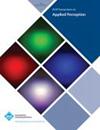文本和代码阅读眼动追踪研究中的线条识别和垂直跳跃解释
IF 1.9
4区 计算机科学
Q3 COMPUTER SCIENCE, SOFTWARE ENGINEERING
引用次数: 0
摘要
眼动追踪研究表明,与阅读文本不同,阅读代码包括许多垂直跳跃。由于不同的代码行可能具有完全不同的功能(例如,变量定义、流量控制或计算),因此准确识别正在读取的代码行很重要。我们设计的实验需要仔细检查一行特定的文本。利用这条线周围凝视的分布,我们计算出识别正在阅读的线的精度如何取决于字体大小和间距。结果表明,即使在校正了系统偏差之后,也可能需要不自然的大字体和间距来进行可靠的行识别。有趣的是,在实验过程中,参与者还反复重新检查他们的任务,以及他们是否在看正确的线,导致类似于阅读代码时观察到的垂直跳跃。这表明,观察到的阅读模式可能是“低效的”,因为参与者觉得有必要重复超出任务所需的最小数量的动作。这可能会对阅读模式的解释产生影响。特别是,阅读不仅仅反映从文本或代码中提取信息。相反,阅读模式也可能反映其他类型的活动,例如获得一般方向,以及在执行特定任务的背景下搜索特定位置。本文章由计算机程序翻译,如有差异,请以英文原文为准。
Identifying Lines and Interpreting Vertical Jumps in Eye Tracking Studies of Reading Text and Code
Eye tracking studies have shown that reading code, in contradistinction to reading text, includes many vertical jumps. As different lines of code may have quite different functions (e.g., variable definition, flow control, or computation), it is important to accurately identify the lines being read. We design experiments that require a specific line of text to be scrutinized. Using the distribution of gazes around this line, we then calculate how the precision with which we can identify the line being read depends on the font size and spacing. The results indicate that, even after correcting for systematic bias, unnaturally large fonts and spacing may be required for reliable line identification. Interestingly, during the experiments, the participants also repeatedly re-checked their task and if they were looking at the correct line, leading to vertical jumps similar to those observed when reading code. This suggests that observed reading patterns may be “inefficient,” in the sense that participants feel the need to repeat actions beyond the minimal number apparently required for the task. This may have implications regarding the interpretation of reading patterns. In particular, reading does not reflect only the extraction of information from the text or code. Rather, reading patterns may also reflect other types of activities, such as getting a general orientation, and searching for specific locations in the context of performing a particular task.
求助全文
通过发布文献求助,成功后即可免费获取论文全文。
去求助
来源期刊

ACM Transactions on Applied Perception
工程技术-计算机:软件工程
CiteScore
3.70
自引率
0.00%
发文量
22
审稿时长
12 months
期刊介绍:
ACM Transactions on Applied Perception (TAP) aims to strengthen the synergy between computer science and psychology/perception by publishing top quality papers that help to unify research in these fields.
The journal publishes inter-disciplinary research of significant and lasting value in any topic area that spans both Computer Science and Perceptual Psychology. All papers must incorporate both perceptual and computer science components.
 求助内容:
求助内容: 应助结果提醒方式:
应助结果提醒方式:


